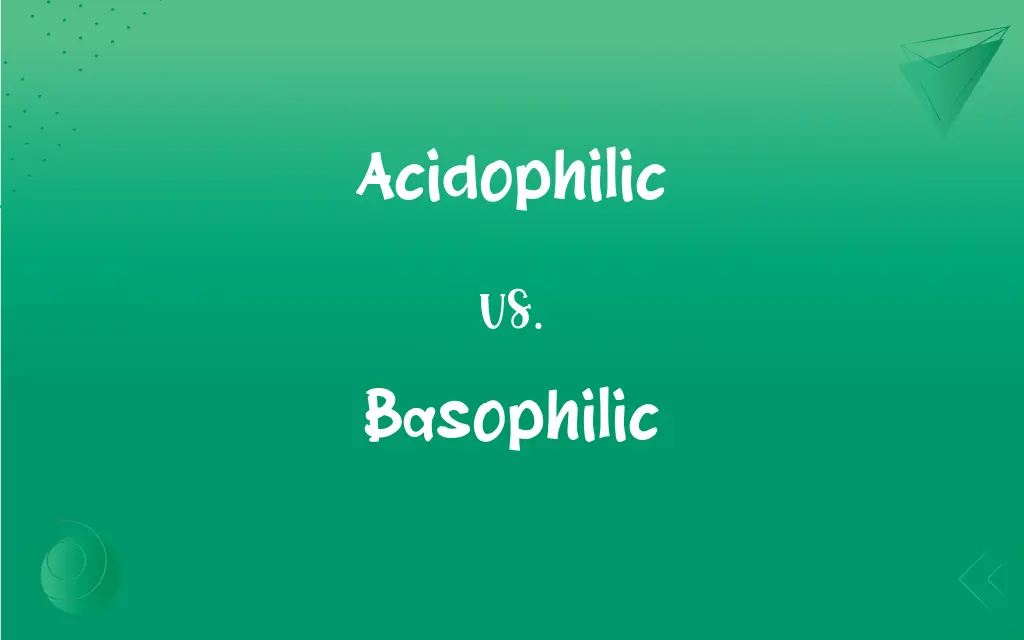Acidophilic vs. Basophilic: What's the Difference?
Edited by Aimie Carlson || By Janet White || Published on December 26, 2023
Acidophilic referring to cells or tissues that readily stain with acidic dyes. Basophilic pertaining to cells or tissues that are easily stained with basic dyes.

Key Differences
Acidophilic cells or tissues have an affinity for acidic dyes, resulting in a reddish or pinkish coloration when stained. This property is due to the presence of basic components like proteins that bind acidic dyes. Basophilic cells or tissues, in contrast, are attracted to basic dyes, turning a bluish or purplish hue upon staining, indicative of acidic components like nucleic acids and glycosaminoglycans.
In histology, acidophilic structures, like cytoplasmic proteins and some organelles, show up distinctly under a microscope after acidic staining. Basophilic structures, such as cell nuclei and ribosomes, are prominent with basic stains due to their high nucleic acid content.
Acidophilic substances in the body typically include enzymes and muscular structures, indicating areas rich in protein. Conversely, basophilic substances are often associated with active RNA synthesis and high metabolic activity, as seen in the endoplasmic reticulum and Golgi apparatus.
In pathology, acidophilic changes can indicate certain types of cellular damage or disease states, such as in liver pathology. Basophilic changes, however, can signify different pathological conditions, including increased cell proliferation or certain blood disorders.
Acidophilic staining is a key tool in identifying muscle fibers and erythrocytes, which are rich in basic proteins. Basophilic staining, on the other hand, is crucial for visualizing cells with high DNA or RNA content, like lymphocytes and immature blood cells.
ADVERTISEMENT
Comparison Chart
Dye Affinity
Attracted to acidic dyes
Attracted to basic dyes
Coloration
Reddish or pinkish after staining
Bluish or purplish after staining
Common Structures
Muscular structures, enzymes
Cell nuclei, ribosomes
Indicative Of
Basic proteins, cell damage
High RNA/DNA content, cell proliferation
Pathological Implications
Indicates certain types of cellular damage
Signifies different pathological conditions
ADVERTISEMENT
Acidophilic and Basophilic Definitions
Acidophilic
Indicates cells rich in basic proteins or structures.
Acidophilic staining helps identify erythrocytes in blood samples.
Basophilic
Characterizing cells that are stained by basic dyes.
The nuclei of cells are basophilic, turning blue with basic stains.
Acidophilic
Reflects a property of certain proteins to bind acidic dyes.
Acidophilic areas in a cell often correlate with protein-rich regions.
Basophilic
Basophilic refers to tissues attracted to basic stains in microscopy.
Basophilic staining is crucial for visualizing RNA-rich ribosomes.
Acidophilic
Acidophilic refers to an affinity for acidic stains in histology.
In liver biopsies, certain acidophilic changes can indicate disease.
Basophilic
Reflects the presence of acidic components like DNA or RNA.
Basophilic staining helps in identifying immature blood cells.
Acidophilic
Used to describe tissue components that react to acidic dyes.
Acidophilic enzymes in cells appear distinct under a microscope.
Basophilic
Indicates a high nucleic acid content in cells or tissues.
Basophilic characteristics in cells often point to active RNA synthesis.
Acidophilic
Pertaining to cells that stain with acidic dyes.
Muscle fibers are acidophilic, staining red with acidic dyes.
Basophilic
Used to describe cellular components that react with basic dyes.
The basophilic Golgi apparatus is easily identifiable in cell staining.
Acidophilic
Growing well in an acid medium
Acidophilic bacteria.
Basophilic
Easily stained with basic dyes. Used of a cell or cell structure.
Acidophilic
Easily stained with acid dyes
An acidophilic cell.
Basophilic
Of or relating to basophils.
Acidophilic
Thriving under acidic conditions; relating to or being an acidophile.
Basophilic
Easily stained with basic dyes, such as haematoxylin.
Acidophilic
Easily stained with acidic dyes, such as eosin.
Basophilic
Staining readily with basic dyes
Acidophilic
Growing well in an acid medium; said of some bacteria
Acidophilic
Especially of some bacteria; growing well in an acid medium
FAQs
How do acidophilic organisms survive acidity?
They have specialized cellular mechanisms to regulate their internal pH.
What does acidophilic mean?
Acidophilic refers to organisms or cells that thrive in acidic environments.
Can acidophilic organisms be used industrially?
Yes, in biotechnology and mining, for processes like bioleaching.
Where are acidophilic organisms found?
They are often found in environments with a low pH, like volcanic soils and acidic hot springs.
What is the role of basophilic cells in the body?
They are involved in immune responses, especially allergic reactions.
Are acidophilic organisms dangerous?
Most are harmless, but some can cause corrosion or spoilage.
Can acidophilic organisms be cultured in labs?
Yes, using specialized acidic growth media.
What does basophilic mean?
Basophilic refers to cells or tissues that readily absorb basic (alkaline) dyes.
What is an example of an acidophilic organism?
Certain bacteria, like Acidithiobacillus ferrooxidans.
Where are basophilic cells commonly found?
In blood, as a type of white blood cell, and in various tissues.
What triggers basophilic cell activation?
Allergens, pathogens, and certain immune signals.
Do acidophilic organisms have medical significance?
Rarely, but some can be involved in disease processes.
Do acidophilic bacteria contribute to environmental processes?
Yes, they play roles in nutrient cycling and mineral decomposition.
Are there acidophilic plants?
Yes, some plants are adapted to grow in acidic soils.
How are basophilic cells identified?
Through staining techniques in microscopy, where they appear dark blue.
Can basophilic cells indicate disease?
Yes, abnormal levels can signify conditions like allergies or infections.
Are basophilic cells involved in inflammation?
Yes, they release histamine and other mediators during inflammatory responses.
Do basophilic cells have subtypes?
Yes, including tissue-resident mast cells.
How do basophilic cells contribute to allergies?
By releasing histamine and other chemicals that cause allergic symptoms.
Can basophilic cell levels vary in different individuals?
Yes, levels can vary due to genetics, health status, and environmental factors.
About Author
Written by
Janet WhiteJanet White has been an esteemed writer and blogger for Difference Wiki. Holding a Master's degree in Science and Medical Journalism from the prestigious Boston University, she has consistently demonstrated her expertise and passion for her field. When she's not immersed in her work, Janet relishes her time exercising, delving into a good book, and cherishing moments with friends and family.
Edited by
Aimie CarlsonAimie Carlson, holding a master's degree in English literature, is a fervent English language enthusiast. She lends her writing talents to Difference Wiki, a prominent website that specializes in comparisons, offering readers insightful analyses that both captivate and inform.






































































